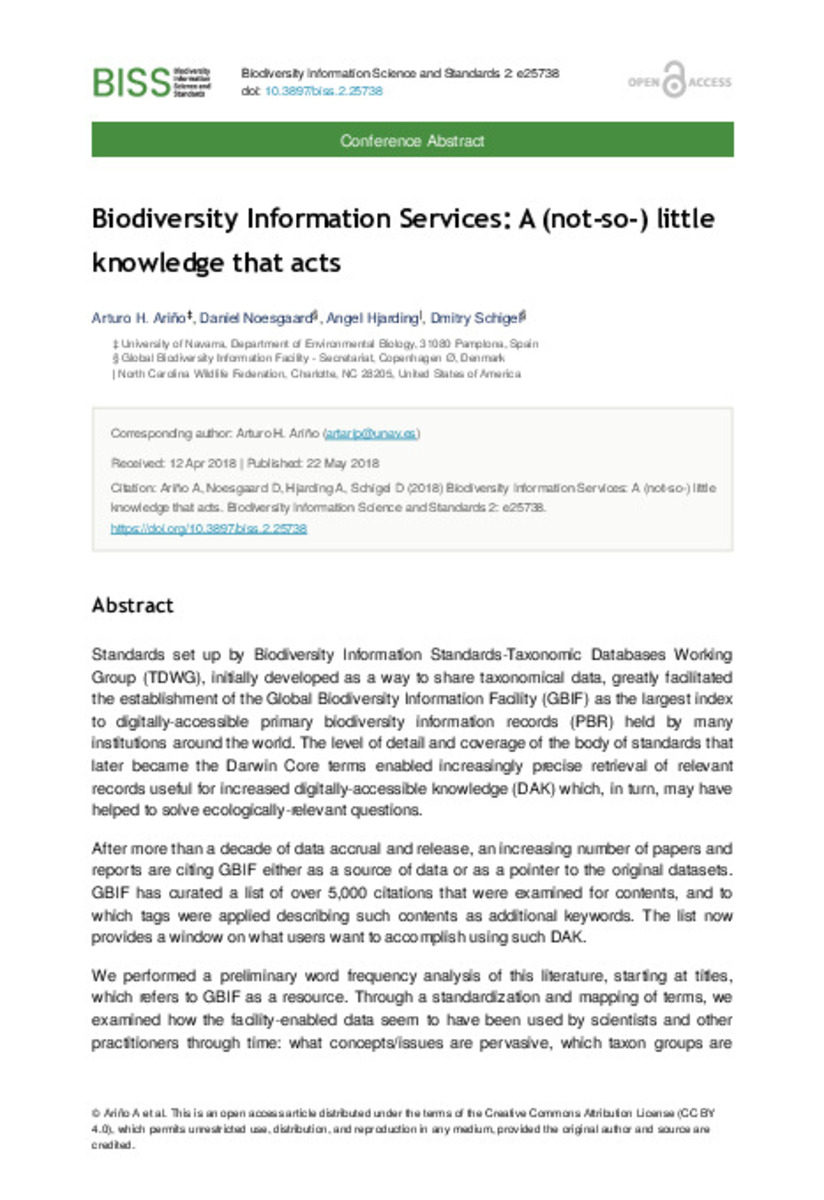Full metadata record
| DC Field | Value | Language |
|---|---|---|
| dc.creator | Ariño-Plana, A.H. (Arturo Hugo) | - |
| dc.creator | Noesgaard, D. (Daniel) | - |
| dc.creator | Hjarding, A. (Angel) | - |
| dc.creator | Schigel, D. (Dmitry) | - |
| dc.date.accessioned | 2023-04-05T11:25:27Z | - |
| dc.date.available | 2023-04-05T11:25:27Z | - |
| dc.date.issued | 2018 | - |
| dc.identifier.citation | Ariño, A.H. (Arturo H.); Noesgaard, D. (Daniel); Hjarding, A. (Angel); et al. "Biodiversity information services: a (not-so-) little knowledge that acts". Biodiversity information science and standards. 2, 2018, e25738 | es |
| dc.identifier.issn | 2535-0897 | - |
| dc.identifier.uri | https://hdl.handle.net/10171/65866 | - |
| dc.description.abstract | Standards set up by Biodiversity Information Standards-Taxonomic Databases Working Group (TDWG), initially developed as a way to share taxonomical data, greatly facilitated the establishment of the Global Biodiversity Information Facility (GBIF) as the largest index to digitally-accessible primary biodiversity information records (PBR) held by many institutions around the world. The level of detail and coverage of the body of standards that later became the Darwin Core terms enabled increasingly precise retrieval of relevant records useful for increased digitally-accessible knowledge (DAK) which, in turn, may have helped to solve ecologically-relevant questions. After more than a decade of data accrual and release, an increasing number of papers and reports are citing GBIF either as a source of data or as a pointer to the original datasets. GBIF has curated a list of over 5,000 citations that were examined for contents, and to which tags were applied describing such contents as additional keywords. The list now provides a window on what users want to accomplish using such DAK. We performed a preliminary word frequency analysis of this literature, starting at titles, which refers to GBIF as a resource. Through a standardization and mapping of terms, we examined how the facility-enabled data seem to have been used by scientists and other practitioners through time: what concepts/issues are pervasive, which taxon groups are mostly addressed, and whether data concentrate around specific geographical or biogeographical regions. We hoped to cast light on which types of ecological problems the community believes are amenable to study through the judicious use of this data commons and found that, indeed, a few themes were distinctly more frequently mentioned than others. Among those, generally-perceived issues such as climate change and its effect on biodiversity at global and regional scales seemed prevalent. The taxonomic groups were also unevenly mentioned, with birds and plants being the most frequently named. However, the entire list of potential subjects that might have used GBIF-enabled data is now quite wide, showing that the availability of well-structured data has spawned a widening spectrum of possible use cases. Among them, some enjoy early and continuous presence (e.g. species, biodiversity, climate) while others have started to show up only later, once a critical mass of data seemed to have been attained (e.g. ecosystems, suitability, endemism). Biodiversity information in the form of standards-compliant DAK may thus already have become a commodity enabling insight into an increasingly more complex and diverse body of science. Paraphrasing Tennyson, more things were wrought by data than TDWG dreamt of. | es_ES |
| dc.language.iso | spa | es_ES |
| dc.publisher | Pensoft Publishers | es_ES |
| dc.rights | info:eu-repo/semantics/openAccess | es_ES |
| dc.subject | Digitally accessible knowledge (DAK) | es_ES |
| dc.subject | Diodiversity | es_ES |
| dc.subject | Literature | es_ES |
| dc.subject | GBIF | es_ES |
| dc.subject | Uses | es_ES |
| dc.subject | Terms | es_ES |
| dc.title | Biodiversity information services: a (not-so-) little knowledge that acts | es_ES |
| dc.type | info:eu-repo/semantics/article | es_ES |
| dc.description.note | This is an open access article distributed under the terms of the Creative Commons Attribution License (CC BY 4.0), which permits unrestricted use, distribution, and reproduction in any medium, provided the original author and source are credited. | es_ES |
| dc.identifier.doi | 10.3897/biss.2.25738 | - |
| dadun.citation.publicationName | Biodiversity information science and standards | es_ES |
| dadun.citation.startingPage | e25738 | es_ES |
| dadun.citation.volume | 2 | es_ES |
Files in This Item:
Statistics and impact
Items in Dadun are protected by copyright, with all rights reserved, unless otherwise indicated.






